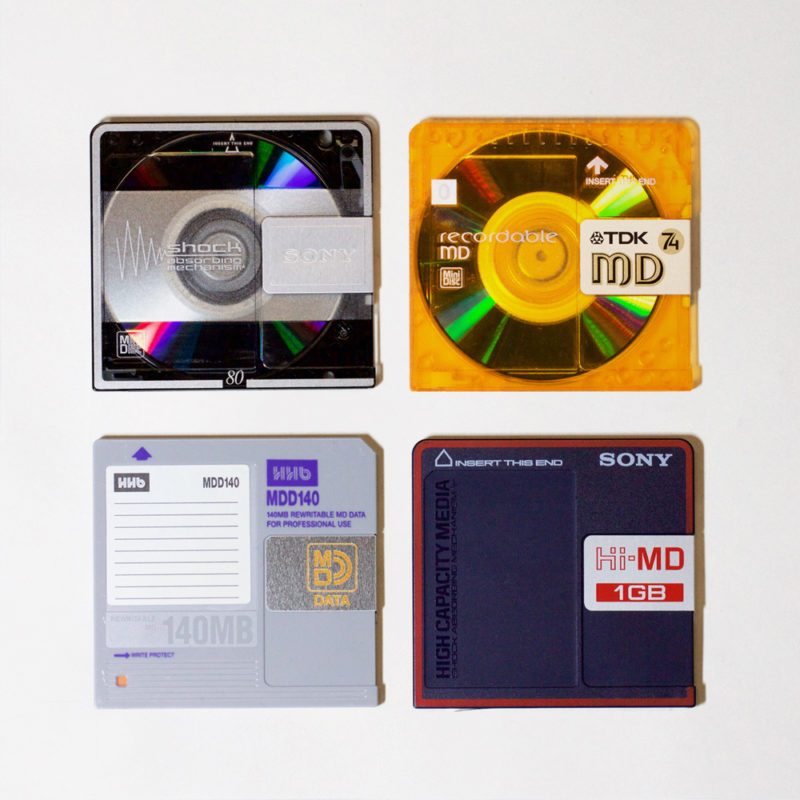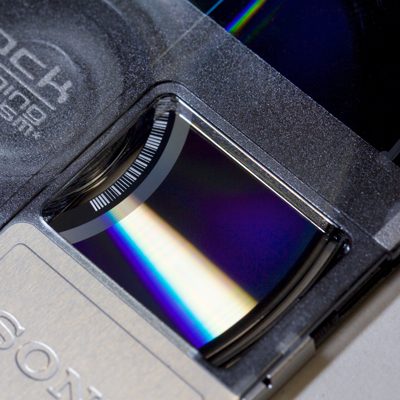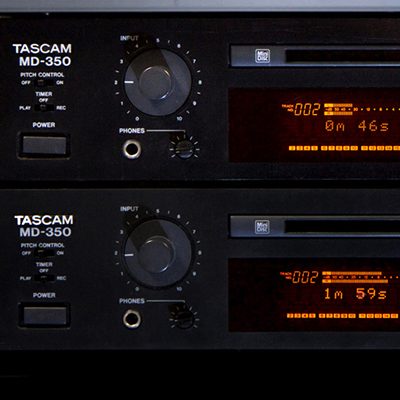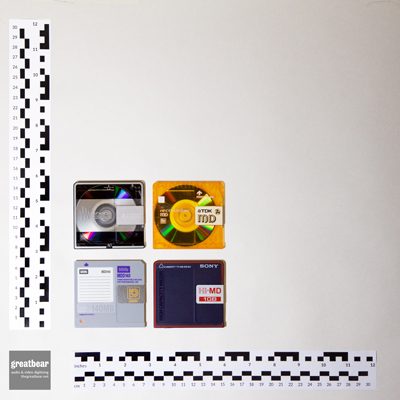introduction to minidisc transfer
MiniDisc is a magneto-optical, disc-based data storage format, developed by Sony in the 1990s. The disc is permanently housed in a small, flat plastic cartridge (68×72×5mm) with a sliding door, similar to the casing of a 3.5" floppy disk.
At Greatbear we cater for stereo or mono Standard Play (SP), Long Play (LP2 and LP4) and Hi-MD (Hi-LP, Hi-SP and PCM) MiniDisc recordings. As a born-digital format, MiniDisc recordings are best transferred digitally to equivalent BWAV audio files.
We offer a range of delivery formats for our audio transfers. Following International Association of Sound and Audiovisual Archives TC-04 guidelines, we deliver high resolution Broadcast WAV files, together with MP3 audio file or audio CD listening versions. We're happy to create any other digital audio files, according to your needs.
We can provide the appropriately-sized USB delivery media for your files, or use media supplied by you, or deliver your files online. Files delivered on hard drive can be for any operating system - MacOS, Windows or GNU/Linux and filesystems (HFS+, NTFS or EXT3).
MiniDisc recordings vary widely in duration and format, so we always assess media before confirming the price of a transfer.
We offer free assessments- please contact us to discuss your project.
minidisc machines
MiniDisc was initially developed as a consumer format and owing to its excellent skip protection, compared to portable audio CD players, became a popular portable format in Japan and Europe. Few commercial recordings were available on MiniDisc but it was popular as a high quality, compact portable recorder and was cheaper compared to portable DAT recorders.
Denon, HHB, Marantz, Sony and Tascam all developed more robust, portable and rack mounted MiniDisc recorders designed for professional use and we have a selection of these that have flexible digital interfacing and easier servicing, although the Magneto-Optical transports in some of these machines are their weak point and will threaten the format with obsolescence as spares become harder to find.
The MiniDisc Data format was used to make 4 and 8 track multitrack machines in the style of the audio cassette Portastudio of the 1980s but with digital audio.
- Denon DN-990R Broadcast MiniDisc Recorder
- HHB MDP-500 Portadisc MiniDisc Recorder
- Sony MDM-X4 4 track multitrack MiniDisc Recorder
- Sony MZ-NH600D HiMD Minidisc Recorder
- Tascam MD-301 MkII MiniDisc Recorder
- Tascam MD-350 MiniDisc Recorder
- Tascam MD 801R MiniDisc Recorder
- Yamaha MD4, 4 track multitrack MiniDisc Recorder
- Yamaha MD8, 8 track multitrack MiniDisc Recorder
minidisc format variation
| MiniDisc formats supported | digital audio transfer supported | faster than realtime usb transfer supported | 4 track multitrack recordings supported | 8 track multitrack recordings supported |
|---|---|---|---|---|
| Stereo SP | ✓ | ✗ | ✗ | ✗ |
| Mono SP | ✓ | ✗ | ✗ | ✗ |
| LP2 | ✓ | ✗ | ✗ | ✗ |
| LP4 | ✓ | ✗ | ✗ | ✗ |
| HiMD SP | ✓ | ✓ | ✗ | ✗ |
| HiMD LP | ✓ | ✓ | ✗ | ✗ |
| HiMD PCM | ✓ | ✓ | ✗ | ✗ |
| MD Data2 650MB (4 / 8 track multitrack) | ✗ | ✗ | ✓ | ✓ |
Scroll to the right to view full table on smaller screens.
minidisc risks & vulnerabilities
Physically, while MiniDiscs are relatively tough as the whole disc is enclosed in a rigid plastic case they have a flimsy, spring loaded, guard flap that is easily bent and damaged with age and careless handling. Given the small size of the disc a missing flap can render a large section of the disc vulnerable to damage and contamination.
While MiniDisc was conceived as a possible replacement for the audio cassette, it never reached anything like the numbers of audio cassettes and audio cassette machines made. As a result there are far fewer surviving MiniDisc machines, spare parts and skills required to keep them working in the future. In addition the laser pickups that are key to the longevity of these machines are only made by Sony and there is a limited supply of these and they're not a part that can be easily repaired, remanufactured or adapted.
minidisc recording history
MiniDisc (MD) was initially intended for the storage of digitised audio, with the later development of Hi-MD capable of storing both audio and data on the same disc. It was a flexible and robust format for its time - often used by reporters and sound recordists as the portable recorders were light, small and much cheaper than comparable DAT recorders launched in the late '80s.
Despite its popularity with musicians and audio enthusiasts, MiniDisc met with only limited commercial success outside Japan, particularly as recordable CDs, flash memory and HDD-based digital audio players became available. Both MD and Hi-MD recording and playback devices have been discontinued by Sony, although blank discs are still available.





